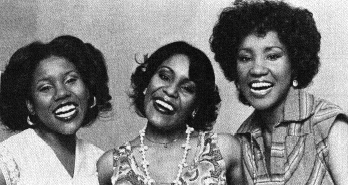|
Wanda, Shelia, and Jeanette made their first appearance in 1958, and a few years later, they hosted their own radio show of religious music. Eventually, the program evolved into a Sunday morning TV series, and the fame of the singing Hutchinsons spread. As the Sunbeams' reputation continued to grow, they began to record, releasing product on several labels before singing with Volt Records in 1968. It was at that time that the group became known as the Emotions.
"We made the transition from gospel to pop at that time," recalled Wanda. "It was then that several friends told our father about how our singing affected them. They said it kind of brought chills, you know, an emotional response. So he thought the best thing to call us would be the Emotions." Producers Isaac Hayes and David Porter were instrumental in the development of a new pop sound for the Emotions. The result was "So I Can Love You," which reached the bottom of America's Top 40 in July 1969. Several follow-up records became R&B hits, and in 1973, the girls made their movie debut in the concert documentary Wattstax. In 1975, their label folded, and the group found themselves without a recording contract. Maurice White, the leader and founder of Earth, Wind and Fire, then signed them to his company, Kalimba Productions. In February 1976, they recorded Flowers, their first album under his direction. Released the following summer, it quietly went gold while the girls were in the midst of a 60-city tour. March of 1977 saw the Emotions and White back in the studio, recording their follow-up album. They decided to call it Rejoice.
"Well, the day we went to rehearse the song in the studio, he said, 'No, Wanda, I meant for you to sing it an octave higher.' So I said, 'Maurice, I've never sung that high in that range.' And he said, 'Well, you don't know if you don't try it.' So we did it, but I was still pretty doubtful. "Well, we were in Baton Rouge on June 29, and we heard the song for the first time on the radio. I still hadn't gotten used to hearing me sounding way up there. But what happened was that when my range got higher, the intensity of my vibrato sharpened a little. It got a cut on it, and people like it. And I've got to say, I've come to like it myself, now." "Best of My Love" broke onto the pop charts in June 1977 and spent 23 weeks on the best-seller lists. Five of those weeks were spent in the number-one position. Later, the record was to earn the Emotions their first Grammy Award, for Best R&B Vocal Performance by a Duo, Group, or Chorus. "Best of My Love" turned out to be a tough act to follow. However, another hit finally came in 1979 -- "Boogie Wonderland," performed in conjunction with Earth, Wind and Fire. "The definition of gospel music, as we understand it, is 'good news,'" said Wanda, "and we don't feel we've ever moved away from the music that brings good news. We appreciate our roots. They're our foundation. They keep us remembering, and always grateful and humble to the Father for having blessed us so. Although our songs are not all directly ones that can be sung in church, they do lift up the spirit. So, in a way, we're still singing the same kind of music we always have."
No comments so far, be the first to comment. |


